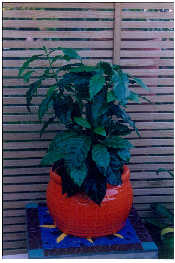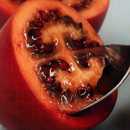Coffee |
Coffea arabica |
| |
||
 |
||
 |
||
 |
||
Coffee has its history as far back as the 9th century. It is thought to have originated in the highlands of Ethiopia and spread to the rest of the world via Egypt and Europe. By the 1500s, the first traders were selling coffee in Europe, and coffee entered into Western life and custom. Coffee is the second most commonly traded commodity in the world.
Landscape Value
Indoors as a foliage specimen or outdoors in a hot sheltered position as a hedgerow or feature plant in a tropical garden.
Nutritional Value
Coffee beans contain high levels of polyphenolics, which can act as excellent antioxidants. The longer the beans are roasted the less antioxidants they contain. High levels of caffine in coffee beans can help clear congestion, help prevent asthma attacks and boast athletic performance. Too much caffine will result in jitters, migraines and / or insomnia. Coffee is addictive, regular users develop intolerance and require more coffee to obtain the desired affect. If deprived of caffeine, withdrawal symptoms can include nausea and headaches. Spent coffee grounds are a good fertilizer in gardens because of their high nitrogen content.
How to Eat
Coffee is a popular beverage prepared from roasted seeds (not beans, though they are almost always referred to as coffee beans) of the coffee plant. Once the beans are cleaned, fermented and dried the beans are roasted. The length of roasting determines the darkest and taste of the coffee. Coffee is usually served hot as your espresso, latte or instant, but also can be served cold. Used in deserts like banoffee pie or as flavouring.
Expected Yield
The coffee tree does not begin to produce its full yield until its sixth year, 0.4 kg per tree
Generic Fruiting Time
| J | F | M | A | M | J | J | A | S | O | N | D |
Growing
Sun
They do best in filtered sunlight and don
Wind
Coffee plants are not wind or salt tolerant.
Climate
Coffee plants prefer warm/hot climates but will tolerant some cold nights. They are not frost tolerant. An ideal house plant.
Soil
Coffee plants prefer a slightly acid soil with plenty of nitrogen. Plenty of moisture and free draining. Can not be planted where there is a clay pan as coffee plants have a tap root. A good potting mix for container growing where they will receive plenty of moisture and nutrients.
Fertiliser
Coffee plants are heavy feeders, regular applications of a complete fertiliser throughout the growing season with additions of compost and organic matter.
Pruning
Prune tips to maintain desired size and shape in late winter early spring.
Pests
Coffee plants suffer from very few pests and those that appear will be when the plant gets stressed. Mealy bug and aphids can be controlled by insecticides available at your local garden centre.
Hardiness
Hardy to -1°C
Special Conditions


